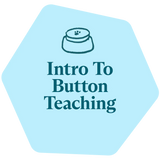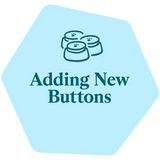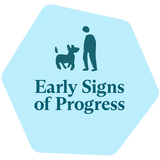Let’s Get Them Pressing (Full)
Basics of Teaching Them to Press
Never pick up your learner’s paw and manually or forcibly press a button with it. This will set their learning back and could cause them to avoid buttons.
Keep their nails short so they have healthy posture and contact with the floor. This will provide more stability and make them more comfortable supporting themselves on three legs if they’re a paw presser or leaning forward if they’re a nose presser.
Throw a party for every press. Whenever a button is pressed, you have to show them what it means. To build their confidence and help them understand what success looks like, make it a big deal when they get it right so they know they’ve done well. Enthusiastically celebrate with your face, voice, and actions. Tell them “yes” or “that’s right,” to help them realize they did it right! Elaborate on exactly how well they’ve done, how proud of them you are, how good, smart, beautiful/handsome, etc they are. As long as your learner enjoys your celebration, there’s no such thing as overdoing it.
All presses are valid regardless of the body part used. Some learners press with their paws. Others will press with their noses, cheeks, or even their bellies. Your learner’s press style is their choice; there is no right or wrong way to do it. Attempting to change your learner’s press style is highly discouraged, and doing so could result in alienating them from using their soundboard.
Select a motivating concept for your target training button.* Choose the concept that is most motivating to your learner and record your word for it on the target button. For example, when using a button for target training that results in a treat, record your word for “treat” on that button.
Incorporate the “tapping fingers technique” whenever you think it’ll help. This refers to the natural pinky to pointer finger or pointer finger to pinky tapping motion people often do on a flat surface. Moving your hand around like this near the button on a HexTile can help draw your learner’s attention to it. The added sound of faint tapping may also grab your learner’s attention. A variation of this technique involves alternating your pointer and middle fingers quickly and lightly tapping over the top of a button to draw their attention to it.
Did you know? The tapping fingers technique is helpful in capturing and directing animals' attention because it incorporates an element of nonintrusive movement. Dog and cat vision has evolved to be particularly sensitive to movement as an advantageous hunting adaptation. The added element of faint tapping or scuffling sounds along with the movement can further boost their intrigue and desire to investigate.
Strategies to Get Them Pressing:
- Enticing Movement
- Strategic Placement
- Formal Button Target Training
Enticing Movement
- Get excited! Enthusiasm is contagious, and you want your learner to pay attention. Your energy should be at: oh my gosh, kiddo, you’ll never believe how cool this thing is. You’re gonna love it! I can’t wait to play with it! It’s gonna be so much fun! It’ll be great for us! I’m telling ya, it is SO cool.
- Set the soundboard down and see if your learner wants to interact with it right off the bat. Get down on their level and face the soundboard while encouraging them to come “see it” with you. “Let’s check it out together!”
- Are they engaged? Try waving your fingers and lightly tapping on top of the button and on the HexTile near the button. Give their “okay you can have it” cue. Let them think about it and see if they’ll investigate.
- If they really seem into it and sniff the button or HexTile but don’t seem to know what else to do with it, try sliding the HexTile back and forth in front of them in quick motions like you might a toy you are trying to get them to interact with. This can trigger them to naturally reach out a paw to steady it or move towards it with their nose.
- If they make contact with the board like this, even if they don’t hit the button, tell them “yes, good” so they know to try a similar move again.
- If they actually manage to touch or press the button, praise them profusely, tell them “yes!” and immediately do whatever super fun thing was recorded on that button.
Strategic Placement
Place the HexTile with the button you’re about to model in a strategic location that the learner may press it themselves, even unintentionally or by accident.
OUTSIDE example: Place the OUTSIDE button right in front of where your learner will step to stand in front of the door you usually let them out of. If needed, open the door a bit so they move forward to sniff at the outside air. If you’ve placed the button properly in their path, chances are they’ll press it eventually. When they do, celebrate and send them outside.PLAY example: Dance your flirt pole, rope, or other toy over to lay atop the PLAY button. They might activate the button when they go for it! You can lure with a toy just like you would with a treat. Place the button in front of one of their paws about a natural step distance away from where it is now. Hold, move, or toss the toy in front of them slightly farther than the button to possibly cause them to step on it. You may have to remind them to “get” the toy however you normally would. If they like tug, you can also entice them to hold onto a toy and help them walk over the button by leading them across the button’s position until it gets activated.
While it’s possible some learners won’t connect the fact THEY activated the button (even if it was by accident) with why you got so excited, but these activities are still worth trying because many will catch on this way.
Button Target Training
Button target training teaches your learner how to press and lets them practice pressing a button repeatedly in a focused way. It also helps build a positive association with buttons which encourages exploration and experimentation.
Practice button target training if your learner:- shows no interest in pressing buttons themself
- is an established button presser who needs to practice technique or precision
Target training refers to teaching a learner to touch something. In the button teaching community, button target training includes methods to:
- Teach learners to press buttons on their own
- Increase interest and comfort in pressing buttons
- Refine pressing technique
- Improve pressing precision and eye-paw or eye-nose coordination
Step-by-Step Button Target Training
Step-by-Step Button Target Training Directions
Quick training terms
Target: The post-it note or button with a post-it note on top of it
Mark: A word like “yes” (or a click) that instantly and clearly tells a learner they’ve done the right thing. It’s a more precise way to teach behaviors because it's immediate and signals to the learner that a reward is coming.
Jackpot: Giving greater amounts of a reward or a higher value reward in response to the learner’s awesome effort or performance
Cue: The word and/or motion you use to ask the learner for specific behavior.
Pro Tip: Reward “in position.” When delivering a treat for a target touch, always hold the treat reward on the target itself. This will connect the reward to the position you want and can lead to more committed and firm presses.
ALWAYS reward your learner no matter what part of their body they use to touch the target or press a button!

To prepare: Choose the concept that is most motivating to your learner and record your word for it on the target button.*
*We refer to the TREAT button as your learner’s target button in the following exercises. However, while target training, you can substitute their word for whatever your learner’s strongest motivator is. If that’s tug, record “play” or “tug” on your target training button and play for 10 seconds to reward instead of giving a treat.
You will need:
- Your target button
- Many small treats
- Mini post-its*
*Blue or yellow post-it notes are ideal because learners can see these colors. If you have regular-sized post-its, you can always cut them to size. They should fit on the button without covering it entirely.
Part 1: Start by teaching “target”
Pro Tip: Rub a yummy treat over the post-it note to make it more interesting. Switch to a fresh post-it once they’ve learned to touch it.
- Place the post-it in the center of your hand.
- Say “target.”
- Extend your flat hand out, holding it a few inches in front of your learner’s nose.*
*Know your learner. If putting something close to their face causes them to move away, hold it farther away so they will investigate it on their own terms. Moving the target slightly away as they lean forward can get them to pursue the target more insistently.
- Encourage them to investigate the post-it. Try pointing or tapping with the other hand to draw their attention to it.
- If they touch it on their own, mark it and reward with a jackpot!
- If they sniff it, you can gently shift the post-it to make contact, then mark immediately upon contact (timing is important) and reward.
- Repeat Steps 1-4 until they have learned that “target” means they should firmly touch the post-it.
- When your learner is consistently targeting the post-it note in your hand (i.e., getting it right more than 80% of the time), stick the post-it on top of your TREAT button. Holding the button in your hand, repeat steps 2 and 3.
- If they actually activate the button, mark, and reward enthusiastically with a jackpot. Repeat at least 8-10 times before moving on to Part 2.
-
If your learner touches the post-it, but not hard enough to activate the button, ask them to target the button again. This time, use your thumb to help them apply pressure when they touch to make sure the button activates. Once the button is activated, reward! With enough repetitions, they learn rewards only appear if the button is audibly activated.
- If your learner seems confused, return to steps 1-4 for a few reps before placing the post-it note on the button. It’s okay to go back!
Part 2: Teach them “target” means press the button
- Hold the back of your hand flat on the ground with the post-it button in your palm face up and say “target.” Ideally, your learner will attempt to press the target button, even though your hand is on the ground. If they don’t, lift your hand only as much as it takes to get them to press the button as they were before. As they catch on, gradually keep asking as you move the target lower and lower to the ground. Mark and reward every time your learner successfully activates the button.
- Once your learner is reliably targeting the button in your hand on the ground (on cue), you can remove your hand, and ask them to target the button on the ground by itself. If they press the button when you say “target,” mark immediately, and reward with a jackpot. Repeat at least 8-10 times.
- Pause for a moment after these repeated repetitions of asking for target. See if they’ll take the initiative to press the button on their own. Give them a full minute– check your phone or look around to feign distraction.
- If they do press it, mark and reward them with a jackpot! This is an awesome way for them to learn they can press buttons on their own. Keep going and reward them every time they press the button on their own without you saying anything for as long as you’re both comfortable. Get at least 10 reps in if you can.
If they aren’t ready to try pressing on their own without being asked, that’s okay too! Keep practicing it on cue! Button target training, even if it’s always on cue, will help build positive associations with buttons. Frequent modeling and sufficiently interesting or motivating buttons choices should lead your learner to begin exploring the soundboard on their own eventually.
Button Target Training for Precision:
Target Issue: Learner is struggling to control which button they’re pressing or doesn’t seem comfortable fully utilizing all the buttons on their soundboard.
Supporting Tips:
Be sure you have optimized your learner’s soundboard button layout so they can comfortably reach each button without activating unwanted buttons. See Planning Your Soundboard for details.
Where’s Target? Game
You will need:
- Regular soundboard set-up
- Target button with a post-it note
- Many small treats
- Put your post-it over the TREAT button again and practice “target” with your learner a few times as a warm-up to refresh their memory.
- Place the target TREAT button with the post-it on top in different locations on your soundboard. Then, ask your learner to press the target button.
- Vary how close the button with the post-it is to other buttons and change its location so they have to reach an area normally wouldn't.
- Every time your learner successfully presses the button, mark and reward them.
Button Target Training for Technique
Target Issue: Learner claws, digs, bites, or otherwise tosses the button out of the HexTile.
You will need:
- A HexTile
- Target button with a post-it note
- Many small treats (opt for less exciting ones for this exercise)
- (Optional) a piece of rolled tape to secure the HexTile to the floor
Directions:
- Practice the classic button target training game.
- Ask them to touch the target button.
- If they claw or otherwise displace the button out of the HexTile, calmly say “oops” and replace the button without giving them a treat so they can try again.
- Repeat asking them to touch the target button.
- You may want to remind them by saying “easy,” “be nice,” “be gentle,” or any other word or phrase you use to ask your learner to interact carefully with something.
- Keep your energy level as low as possible while still responding to them. Speak softly and soothingly, slowing your words and movements down to help bring their energy level down to a more manageable level.
- For “heavy paw-ers,” you can ask them to press while lying down or slightly raise the HexTile off the ground to increase the difficulty and discourage exaggerated scooping motions with their paw.
- When they interact with the button carefully (or at least less aggressively), mark and reward them while maintaining low energy if that’s what they need. Only reward your learner when the button remains in place in the HexTile
If you have questions or feedback regarding this content, please email us at learning@fluent.pet









